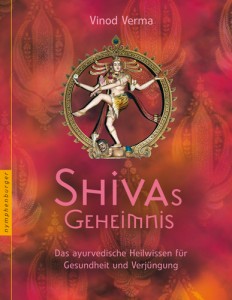Search results for ayurve (1451)
AYURVEDIC LIFESTYLE & DAILY ROUTINES
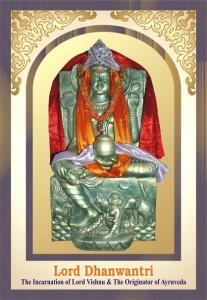
HERBALsUK
> THE ONE STOP HERBAL E-SHOP <
> DINACHARYA – DAILY CONDUCT <
Ayurveda (DevanÄ�garÄ�: आयुर्वेद, the ’science of life‘) is a system of traditional medicine native to the Indian Subcontinent and practiced in other parts of the world as a form of alternative medicine.In Sanskrit, the word Ayurveda consists of the words Ä�yus, meaning ‚life‘, and veda, meaning ‚related to knowledge‘ or ’science‘.Evolving throughout its history, Ayurveda remains an influential system of medicine in South Asia.The earliest literature of Ayurveda appeared during the Vedic period in India.The Sushruta Samhita and the Charaka Samhita were influential works on traditional medicine during this era.Ayurvedic practitioners also identified a number of medicinal preparations and surgical procedures for curing various ailments and diseases. Read more: > HERE <
Ayurveda, regarded as a Holistic manual of Life & Age, describes a lifestyle that’s in harmony with nature. The Ayurvedic description of health is :
„Samadosha, Samadhatu Samagnischa, malkriyah,
(समदोष: समधातु समाग्निश्चा मलक्रियः)
Prasannatmendriyamanah, Swastha ityabhidhiyate
(प्रसन्नात्मेंद्रियामन: स्वस्थ इत्याभिधियते)“
i.e Only he, whose doshas (Vata, Pitta, Kapha) dhatus (physical components – Rasa, Rakta, Mansa, Meda, Asthi, Majja & Shukra i.e. Plasma, Blood, Flesh, Fats, Bones, Bone marrows & Semen respectively) & agni (digestive fire) is balanced, appetite is good, all tissues of the body and all natural urges are functioning properly, and whose mind, body and spirit (self) are cheerful or full of bliss, is a perfectly healthy person. Ayurveda considers the individual as whole and seeks to re-establish harmony between all the constituents of the body and a perfect balance of the tripod – Mind, Body and Spirit. Basically Ayurveda is Health promotive – preventive – curative and nutritive – all self contained.
The two principle objectives of Ayurveda are :
- Swasthasya swasthya rakshanam (स्वस्थस्य स्वास्थ्यरक्षणं)‘ – To prolong life and promote perfect health (add years to life and life to years )
- ‚Aturasya vikar prashamanamcha (अतुरस्य विकार प्रशमनाम्चा)‘ – To completely eradicate the disease and dysfunction of the body.
Ayurvedic approach to Life-style:
Health is greatly influenced by Life-Style (Swastha-vritta). According to Ayurveda, Life-style (the rules and guidelines) is divided into three parts:
1. Dincharya ~ दिनचर्या (Diet and regimen for the daytime)
2. Ratricharya ~ रात्रिचर्या (Diet and regimen for the night)
3. Ritucharya ~ ऋतुचर्या (Seasonal Diet and regimen) and Sandhikal (diet instructions for the joint period of two seasons)
One more thing that is very helpful for the knowledge of proper life-style ‚Samsarjan karm (संसर्जन करम)‘ means specific diet program after illness or after Panchkarma Treatments. For perfect health, long disease free body status, one must follow these instructions.
One way to describe the Lifestyle is in terms of the doshas, Vata, the air element; Pitta, the fire element; and Kapha, the water element. Vata is dominant from 2 to 6 in the morning and afternoon. Kapha is dominant from 6 to 10 in the morning and evening, and Pitta is dominant during mid day and midnight. (10 to 2) Keep in touch with these energies during the day and move with them, not against them.
Daily Routine In Ayurveda
Wake Up:
In Ayurveda, the night time is divided into 16 periods, starting from the sunset (of the previous day) to the sunrise of the following day. Ayurveda Rishis suggest that the ideal time to wake up is during the 14th period, which is about two hours prior to sunrise, around 4.00 am to 5.00 am. This is primarily due to the fact the sattva in the air is at its maximum during the time. In fact, it is the most fresh and pure time of the entire day and the time when Prana-vayu is flowing (air carrying the purest form of oxygen).
After Waking Up
Right after waking up to start the day, one should take a moment to see true nature. To serve the purpose, take a short stroll outside the home and soak up the good vibes and see what life is beyond the four walls of home.
Eliminate
Be sure to eliminate the body’s waste products to empty the colon & bladder, to avoid illnesses. It is always suggested not to wait until later in the morning or during the day, to defecate.
Clean Yourself
Brush teeth, scrape tongue and floss mouth. Wash eyes with rose water and ears with water. Gargle with warm water. One may also use a cup of herbal tea for the purpose. By cleaning the senses, one would be prepared for the day.
Give An Oil Massage
Dryness in the tissues of the skin is a major part of aging. This is the reason why many people show the signs of aging at a very young age. Therefore, abhyanga or oil massage is highly recommended. Typically, a self massage, the morning abhyanga rejuvenates the skin and nurtures your mind and soul.
Exercise
Vyayama or exercise is an important part of dincharya. Physical exercise can be yoga, a walk, tai chi, swim or whatever that provides exercise to your muscles. Not strenuous though, simple exercises would make a huge difference in one person – the exercises would provide one with the much needed energy and activeness for the day.
Take A Bath
Bathing is inevitable in the dincharya, as recommended by Ayurveda. Warm water baths are usually suggested, but one may opt for a shower in cold water as well. Apart from cleaning the body, bathing also stimulates the digestive fire.
Meditate
Meditation refreshes the mind, increases the concentration power and builds the energy needed for the rest of the day. Before trudging into the dining hall, sit in peace for a little while, say, ten minutes.
Breakfast
Breakfast should be moderate, with maximum nutrients. By doing this, one is able to get the optimum amount of energy needed to stay active until the next meal. Kick-start the day with a healthy breakfast. Be sure not to skip the breakfast, because it is the first meal of the day.
Lunch
After four to five hours of breakfast, it is the time to have lunch. Since this is the main meal of the day, one needs to eat a nutritious lunch, with moderate calorie intake. After having lunch, it is suggested to go for a little walk, say, for five minutes. This helps proper digestion of food.
Twilight
Twilight is the special time, which is a balance between the day and the night. Evening prayers, meditations should be carried out during twilight, because it is the best time to see one’s Inner Self.
Supper
Ayurveda recommends supper time between 6 pm to 8 pm. However, it is not practical in this fast moving life. It is still advisable to have dinner before you exhaust completely, but definitely two hours prior to going to bed. After the dinner is over, take a walk for a short while, say, fifteen minutes.
Go To Bed
After having dinner, it is the time to relax. Spend some quality time with your family. Sit back and relax. Read a book or listen to soothing music. This is the time to calm your system down. Thereafter, one should have a sound sleep of 6 to 7 hours.
Follow a Seasonal Ayurvedic Routine
Follow seasonal recommendations to balance the vata, kapha and pitta doshas. Each of these mind-body types is more active during particular seasons. The seasonal directives for each are guides to keep them balanced.
1. Eat light foods and drink water with honey during Fall.
2. Chew each bite of food 32 times as it helps in keeping the stomach light.
3. Pass Urine after each meal as it helps in keeping the kidneys active.
4. Have regular baths and oil massages and avoid napping during the day.
5. Choose foods that are heavy during winter and drink warm water, cow’s milk or juice.
6. Have a tepid bath after your oil massage, dress warmly and exercise.
7. Drink more fluids during the summer. Avoid foods that are pungent, acidic or salty.
8. Wear light clothes and avoid strenuous exercise.
9. Avoid foods that are cold, sour, sweet or difficult to digest during spring.
10. Avoid daytime naps but have lots of oil massages and vigorous exercise.
> Dein Ayurveda Net: ….. > Ayurveda, Ursprung, Geschichte <
> Dein Ayurveda Net: ….. > Jahreszeiten im Rythmus der Bioenergien <
> Meet Jaya Kula and the three ways of Practicing tantra at facebook <
> Meet Herbals and Naturals and friends at facebook <
PRIME TREATMENTS IN AYURVEDA
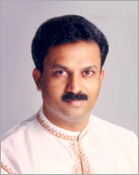
Dr. E. Shaji Raj, www.punarjanis.com
> PRIME TREATMENTS IN AYURVEDA <
Centuries ago, the enlightened masters, in search of spiritual solace, composed the Ayurveda, for the welfare of humanity. According to the scriptures, the human body is made up of 72000 channels connected to the seven spiral energy centers, the diseases of body and mind, which in turn block the path to spiritual enlightenment. The Panchakarma treatment aims at cleansing these channels, pacifying the disease and nourishing the body. It provides longevity, immunity against the disease, whereas in ancient times Yoga, Astrology, Tantra, and Ayurveda were practiced not for longevity but as an ultimate path to enlightenment.
In those ages Ayurveda and self-realisation were cognate and the people held this science in veneration. In the present world it is seen as merely a tool to cure human ailments. More over the practitioners of Ayurveda were Yogis, who would hold the stretched arms of the patients in their hands locate the pulse points and close their eyes as if in a deep trance. Seconds later, they would recount the diagnostic findings one by one. They never had any clinical laboratory or any other technological devices. The innate propensity of certain punarjanis were so splendid that it could work wonders to cure the diseases.
The physician:
Inspired by the findings of the Ayurveda masters we have formulated a system of treatment at ‚Punarjanis‘ bringing the ancient teachings to the limelight in an attempt to serve humanity. We focus on patients with chronic intractable ailments where routine medicine is only palliative.
Dr. E. Shaji Raj, a disciple of Bhramashri Parabattaraka Ananganandanathan Padathirtha, completed his > BAMS < from Madras University. Hailing from a family of traditional Ayurvedic physicians, he has been doing active research in the field of healing for the past 16 years – primarily related to raising energy from the lower center of the body to the higher center. He is one among the few ayurvedic physicians around the world who practice pulse reading and panchakarma treatment.
Incorporating the philosophy and the gist of Ayurveda with the root idea of Tantra and Yoga, the final result is not just cure, but a sea change – a path to enlightenment and bliss. The results have been amazing – an enlightened mind in a sound body.
Adi Shankara:
Adi Shankara (Malayalam:ആദി ശങ്കരന്, DevanÄ�garÄ�: आदि शङ्कर, Ä�di Śaṅkara, pronounced [aːd̪i ɕaŋkərə]); (788 CE – 820 CE), also known as Śaṅkara BhagavatpÄ�dÄ�cÄ�rya and Ä�di ŚaṅkarÄ�cÄ�rya, was an Indian philosopher who consolidated the doctrine of Advaita Vedanta, a sub-school of Vedanta. His teachings are based on the unity of the soul and Brahman, in which Brahman is viewed as without attributes. He hailed from Kalady of present day Kerala.
Shankara travelled across India and other parts of South Asia to propagate his philosophy through discourses and debates with other thinkers. He founded four mathas („monasteries“), which helped in the historical development, revival and spread of Advaita Vedanta. Adi Shankara is believed to be the organizer of the Dashanami monastic order and the founder of the Shanmata tradition of worship.
His works in Sanskrit, all of which are extant today, concern themselves with establishing the doctrine of Advaita (Nondualism). He also established the importance of monastic life as sanctioned in the Upanishads and Brahma Sutra, in a time when the Mimamsa school established strict ritualism and ridiculed monasticism. Shankara relied entirely on the Upanishads for reference concerning Brahman and wrote copious commentaries on the Vedic Canon (Brahma Sutra, Principal Upanishads and Bhagavadgita) in support of his thesis. The main opponent in his work is the Mimamsa school of thought, though he also offers some arguments against the views of some other schools like Samkhya and certain schools of Buddhism that he was familiar with.
Read More here : > HERE <
> Meet all Ayurveda Friends, Groups, Studies at facebook <
> Meet all Buddhism Friends, Groups, Studies at facebook <
> Meet all Hinduism Friends, Groups, Studies at facebook <
> Meet FREE visa to india for MBA , degree Programs, it jobs at fb <
> Meet Vedanta Studies, Friends, Yoga, Int. Society, Groups at fb <
THE MOST TRUSTED NAME IN AYURVEDA
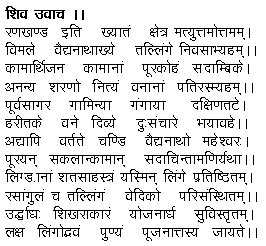
Baidyanath Mahatmya (mentioned in several Puranas)
Fusion of ancient knowledge
with modern scientific revelation.
> Ram Dayal Joshi Memorial Ayurvedic Research Institute <
Baidyanath is one of the oldest and most popular pharmaceutical firm specialising in Ayurvedic medicines.It has been manufacturing many highly popular items like Chyawanprash and Dashmularishta for several years. Shree Baidyanath Ayurved Bhawan (p) Limited was founded in 1917 by Late Pt. Ram Dayal Joshi. Its registered office is in Kolkata. To encourage and boost research in Ayurveda, Baidyanath established Pt. Ram Dayal Joshi Memorial Ayurvedic Research Institute at Patna in 1971. Baidyanath Group awards two hundred thousand rupees every year for the best research paper or book on Ayurveda. Read More: > here<
Ayurveda is a 5000 year old Science of health care and herbal treatment. Ayurveda, is highly effective in common and complicated ailments, assures long term relief and has no side effects. Ayurveda is now backed by modern scientific research and technologies and provides its gentle healing touch to millions around the world.
One of India’s most respected Companies, Shree Baidyanath Ayurved Bhawan (p) Ltd. (Kolkata), popularly known as Baidyanath, is the acknowledged leader of Ayurvedic know-how. Established in 1917, the Company has played a pioneering role in re-establishing ancient knowledge with modern research and manufacturing techniques.
Shree Baidyanath Ayurved Bhawan (p) Ltd. was founded in 1917 by Late Pt. Ram Dayal Joshi. Its registered office is in Kolkatta. To encourage and boost research in Ayurveda, Baidyanath established Pt. Ram Dayal Joshi Memorial Ayurvedic Research Institute at Patna in 1971. Baidyanath awards two lakh of rupees every year for the best research paper or book on Ayurveda.
> Meet Ayurveda, Groups, Studies, Friends, Fans at facebook <
EINFÜHRUNGSABEND AYURVEDA

> DEUTSCHE AYURVEDA AKADEMIE <
Kostenloser Einführungsabend zu den Ausbildungsseminaren in der Kaiserkrone
Die Deutsche Ayurveda Akademie und die Apotheke zur Kaiserkrone laden Sie herzlich ein zum kostenlosen Infoabend zur Ayurveda- Ausbildung. Sie erfahren alles Wissenswerte zu den 5 aufbauenden Seminarbausteinen, die mit einem zertifizierten Diplom ausgezeichnet werden.
Leitung: Dr. med. Wolfgang Schachinger
Termin: Freitag, 6. 11. 2009
von 18.30 – 20.30 Uhr
Kursort: Seminarraum Kaiserkrone
1070 Wien, Mariahilferstr. 108
Preis: kostenlos
Vortrag: Inhaltliche Fragen zur Ayurveda-Ausbildung
Für Fragen: Dr. Wolfgang Schachinger +43 (0) 7752-86622
Eva Bradshaw +49 (0) 9431-7589408
Weitere Info zur gesamten Ausbildung: PDF Programm und Info über Weiterbildung der DAA mit Apotheke zur Kaiserkrone
> Meet Swami Maharshi Groups, Friends, Studies at Facebook <
> Dein Ayurveda Net ….. ” Ayurveda ” <
> Meet Pentavox Herbals, Ayurveda (Biggest Ayurveda Group on fb) <
> Meet many Ayurveda Groups and Friends at facebook <
> Meet Dhanvanthari Groups and Friends at facebook <
> Meet NaturalNews.com at facebook <
NaturalNews.com is an independent news resource that covers the natural health and wellness topics that empower individuals to make positive changes in their personal health. NaturalNews offers uncensored news that allows for healthier choice.
DIE VEDEN & AYURVEDA, EIN ÜBERBLICK
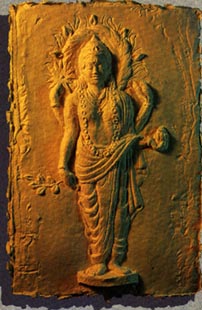
> CHARAKA SCHOOL OF AYURVEDA <
> AYURVEDA & CHARAKA SAMHITA <
>> Books from „Kenneth G. Zysk“ <<
Ayurveda (DevanÄ�garÄ�: आयुर्वेद, the ’science of life‘) is a system of traditional medicine native to India and practiced in other parts of the world as a form of alternative medicine. In Sanskrit, the word Ayurveda consists of the words Ä�yus, meaning ‚life‘, and veda, meaning ‚related to knowledge‘ or ’science‘. Evolving throughout its history, Ayurveda remains an influential system of medicine in South Asia. The earliest literature of Ayurveda appeared during the Vedic period in India. The Sushruta Samhita and the Charaka Samhita were influential works on traditional medicine during this era. Ayurvedic practitioners also identified a number of medicinal preparations and surgical procedures for curing various ailments and diseases. Ayurveda traces its origins to the Vedas—the Atharvaveda in particular—and is connected to Hindu religion.The Sushruta Samhita of Sushruta appeared during the 1st millennium BC.
Ayurveda, Rishis, die 4 VEDEN (Rgveda, Samaveda, Yajurveda, Arthavaveda) und deren Entstehung:
Der Begriff Ä�yurveda ist ein Wort aus dem Sanskrit, der altindischen Hochsprache, und heißt einfach übersetzt „Wissenschaft vom Leben“ oder „Wissen von der Lebensspanne“. Durch diese Bezeichnung versteht sich, dass im Ä�yurveda nicht nur Krankheiten behandelt werden. Als „Wissenschaft vom Leben“ hat Ä�yurveda ein zweifaches Ziel.
> Dein Ayurveda Net ….. “ Ayurveda “ <
> Meet Pentavox Herbals, Ayurveda (Biggest Ayurveda Group on fb) <
> Meet many Ayurveda Groups and Friends at facebook <
> Meet Dhanvanthari Groups and Friends at facebook <
> Meet NaturalNews.com at facebook <
NaturalNews.com is an independent news resource that covers the natural health and wellness topics that empower individuals to make positive changes in their personal health. NaturalNews offers uncensored news that allows for healthier choice.
Geschichte des Ayurveda; Ursprung Ashtanga
>> Ayurveda a system of traditional Medicine <<
Was verstehen wir heutzutage unter Ayurveda ?
Betrachtet man den gegenwärtigen Gebrauch des Begriffes Ayurveda, so kann man vier Bedeutungen unterscheiden:
1. Ä�yurveda bezeichnet eine traditionelle gelehrte medizinische Wissenschaft im Indischen Kulturbereich. Auch heute noch wird Ä�yurveda gelegentlich im traditionellen Kontext gelernt. Eine solche Ausbildung erfolgt meist in engem persönlichen Kontakt zu einem Lehrer und ist eingebettet in eine umfassende traditionelle Bildung. Beispielsweise werden eine solide Kenntnis der klassischen grammatischen Wissenschaft des Sanskrit und der klassischen indischen Philosophie als Voraussetzungen für diese Art der traditionellen Ausbildung angesehen. Grundlage für diese Ausbildung sind die klassischen Texte der Ä�yurvedischen Wissenschaft, die in Sanskrit verfasst sind.
2. Ä�yurveda ist heute ein eigenständiges professionalisiertes Medizinsystem in Indien. Im 19. und 20. Jahrhundert hat der Ä�yurveda in Indien einen tiefgreifenden Wandel erfahren, der äußerlich dadurch gekennzeichnet ist, daß die Ä�yurvedische Ausbildung und Berufsausübung nach dem Vorbild der Biomedizin professionalisiert wurde. So wird Ä�yurveda heutzutage an Hochschulen gelehrt und nach einem fünfeinhalbjährigen Studium kann die Approbation als Ä�yurvedischer Arzt (B. A. M. S., d. h. „Bachelor of Ayurvedic Medicine and Surgery“) erlangt werden. Zudem existieren auch eigene Ä�yurvedische Ärztekammern und Forschungsräte.
3. In Europa und Nordamerika ist in den letzten zwei Jahrzehnten eine besondere Form des Ä�yurveda verbreitet worden, die man in Anlehnung an Kenneth G. Zysk (Zysk 2001) „New Age Ayurveda“ nennen kann. Diese Spielart des Ä�yurveda ist gekennzeichnet durch eine übermäßige Betonung von Spiritualität. Die klassische Ä�yurvedische Tradition hat im Gegensatz dazu die religiös-spirituellen Aspekte immer von der ayurvedischen Heilkunde unterschieden.
„Der klassische Ä�yurveda in Indien hat die medizinische Ausbildung des Ä�yurveda bewusst getrennt von der spirituellen und religiösen Disziplin der yogischen Askese.“
4Kenneth Zysk, Indologe (2001, p.24)
4. Ebenfalls in Europa und Nordamerika wird Ä�yurveda in den letzten Jahren oft in den Bereich von „wellness“, d. h. Maßnahmen zur Erhaltung und Steigerung von Wohlbefinden, eingeordnet. Dabei wird die heilkundliche und therapeutische Dimension des Ä�yurveda vollkommen außer Acht gelassen.
4 Quelle: Kenneth Zysk,Kenneth G.Zysk: Medicine in the Veda. Religious Healing in the Veda
EWAC – European World Ayurveda Congress

> EWAC – European Ayurveda Congress <
> EUAA – Ayurveda Association <
( Hier entsteht die neue Internet-Seite v. EuAA – Europ. Ayurv. Ass.)
Die > European Ayurveda Association (EUAA) < vertritt als europäische Dachorganisation die Interessen des Ayurveda aus 27 Ländern. Ziele und Aufgaben sind die Förderung des Ayurveda als ganzheitliches medizinisches System mit 5.000-jähriger Tradition, die Gestaltung einheitlicher Standards zur Ausbildung und Anerkennung durch die Gesundheitsbehörden, die Definition und Sicherung der Qualitätsstandards für ayurvedische Produkte europaweit.
Press Release European Ayurveda Association (EUAA) Nigel Hubbers – General Secretary – EUAA
On 10th and 11th October Baden-Baden Congress House in Germany will be host the largest and most significant Ayurvedic event ever to have been staged outside India.
The two day event in the intimate and up to date Conference and exhibition Centre is an invitation to all those who want to experience Ayurveda for the first time or those who want to learn and experience another aspect of this ancient system of Indian medicine to come and enjoy the European World Ayurveda Congress EWAC 2009 ….. Read the full information by: > Ayurveda-Portal <
Neem Tree, Ayurveda, Medicine & Worship
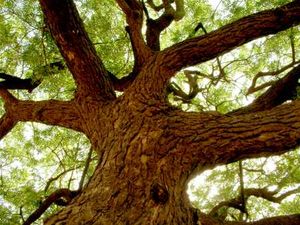
Holy Neem Tree – Azadirachta indica
> NEEM – Ayurveda, Medicine & Hindu Worship <
Neem (Azadirachta indica, syn. Melia azadirachta L., Antelaea azadirachta (L.) Adelb.) is a tree in the mahogany family Meliaceae. It is one of two species in the genus Azadirachta, and is native to India, Myanmar, Bangladesh, Sri Lanka, Malaysia and Pakistan, growing in tropical and semi-tropical regions. Other vernacular names include Neem (Bengali), Arya Veppu (Malayalam), Azad Dirakht (Persian), Nimba (Sanskrit and Marathi), DogonYaro (in some Nigerian languages), Margosa, Neeb (Arabic), Nimtree, Vepu, Vempu, Vepa (Telugu), Bevu (Kannada), Kohomba (Sinhala), Vempu (Tamil), Tamar (Burmese) and Indian Lilac (English). In East Africa it is also known as Mwarobaini (Swahili), which means the tree of the 40, as it is said to treat 40 different diseases.
Der Neem-Baum war bis vor wenigen Jahren in Indien, Burma, Thailand und weiteren angrenzenden Staaten beheimatet. Etwa in den sechziger Jahren unseres Jahrhunderts wurde er auch in Afrika und einigen tropischen Inseln kultiviert.
Der einzige Grund, warum der Baum nicht den Weg nach Europa gefunden hat ist der, dass er zwar große Hitze und hohe Luftfeuchtigkeit problemlos verträgt, jedoch äußerst kälteempfindlich ist.
Seit tausenden Jahren werden die einzelnen Teile des Baumes in Indien und anderen Regionen als Pflege- und Heilmittel eingesetzt.
Im Ayurveda, der uralten indischen Medizinschule sind die Produkte des Neem-Baumes ein integrierter Bestandteil.
Über Auftrag der WHO – Weltgesundheitsorganisation, arbeiten zwei voneinander unabhängige Institutionen in Amerika an der Erforschung der vielgestaltigen Einsatzmöglichkeiten von Neem-Produkten.
Das eine Institut ist die Neem Association und das zweite die Neem Foundation.
In Europa befasst sich seit den siebziger Jahren Prof. Schmutterer von der Universität Gießen mit der Neem-Forschung.
Die Ergebnisse aller drei Labors sind in den wesentlichen Punkten die gleichen:
-
Neem-Produkte wirken sowohl bei innerlicher, als auch bei äußerlicher Anwendung.
-
Neem-Produkte werden aus Blättern, Rinde und Samenkernen hergestellt.
Blätter und Rinde werden getrocknet, zerstoßen und zu Tees und Extrakten verarbeitet. Aus den Samenkernen wird nach dem schälen und mahlen das hochwirksame Neem-Öl gepresst. Der dabei anfallende Pressrückstand wird als Neem-Cake (Presskuchen) ebenfalls weiterverwendet.
Weitere Institute, die sich mit der Neemforschung befassen:
-
State University New JerseyProf. Maramorosch
-
UCLA – Universität Los Angeles Forschungsbericht
-
Hochschule Weihenstephan BRD Instititut für Botanik und Pflanzenschutz
-
Prof.DI Thomas Lohrer
-
Max Planck Institut
-
Umweltingenieursbüro OETZEL BRD Umweltanalysebericht
Der Neem-Baum, der aus Indien stammt und dessen botanischer Name Azadiracta Indica lautet, hat eine lange Tradition auf dem Subkontinent.
Der Begriff Azadiracta ist eine Ableitung und Neukombination aus den Sanskritwörtern Azad und Draksha, was soviel wie „Baum der Freiheit“ bedeutet.
Der Neem-Baum stand und steht im Ruf, Menschen, Tiere, Ernte und die Erde vor Krankheiten und anderen Übeln zu schützen.
Seit Jahrhunderten benutzen indische Bäuerinnen und Bauern die Blätter und Samen des Neem-Baumes als natürliches Pflanzenschutzmittel.
Die Pflanze produziert ein Öl, das andere Nutzpflanzen vor dem Befall durch Pilze und Insekten schützt.
Es war die Natur, die den Wirkstoff durch molekulare Evolution entwickelt hat, und es waren indische Bauern, die sich dieses „Naturgeschenk“ zu Nutze gemacht haben.
Den Hindus gilt der Baum als heilig.
Der Neem-Baum braucht wenig Wasser, gedeiht auf fast jedem Boden, spendet Schatten und Kühle, weswegen er bevorzugt vor Wohngebäuden, Tempeln und auf Viehweiden gepflanzt wird und sorgt für reine, gesunde Luft.
Kranke schlafen auf seinen gesundheitsfördernden Blättern, Gesunde reiben sich die Haut mit seinen heilende Blättern ein, in Reissäcken schützen die Blätter die kostbare Nahrung und das Saatgut vor Reisschädlingen und auch bei der Zahnpflege ist der Neem-Baum unentbehrlich.
Kleine Ästchen werden gekaut, um die Zähne weiß und sauber zu halten und vor Krankheiten zu schützen.
Wer es westlicher liebt, kann auch Neem-Zahncreme erwerben.
Mit einem Wort: Seit Jahrhunderten werden der Neem-Baum, sein Holz, seine Früchte, seine Samen und sein Öl zum Wohle aller frei und uneingeschränkt verwendet und so soll es auch bleiben.
Die Autorin ist Mitarbeiterin beim Umweltinstitut München und im Beirat des Gen-ethischen Netzwerkes.
Quelle: www.dosha.at
Ayurveda Under Cultivation
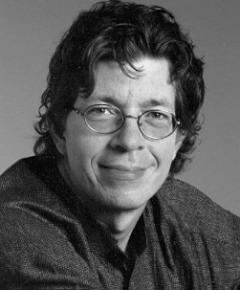
Robert E. Svoboda
>> AYURVEDA SVOBODA, BOOKS & GALLERY<<
>> BRIHAD ARYANKA UPANISHAD <<
Ayurveda Under Cultivation
An aranyaka is an ancient Vedic text that was composed in, and meant to be studied in, a forest. Though the texts of classical Ayurveda were written with urbanites in mind, they are verily aranyakas in spirit, for they carry to city dwellers an urgent „back to Nature“ message. To better access that message let us for a moment remove ourselves from the metropolis, and imagine that we are seated under a spreading banyan tree that shades an Ayurvedic guru’s ashram.
The guru sits, dispensing teachings and healings, inspired by the tree’s prana, guided by its intelligence, permitting the natural curative energy of the universe to flow through into student and patient, resisting the blandishments of the ego that yearns to claim doership. Ayurveda herself is a living entity – we can call her the Ayur Vidya – who, being an innate property of the cosmos, exists mainly in the non-physical world. The Ayur Vidya, who develops and spreads in our world solely by finding suitable hosts here, sends her shakti into the substances used in healing and the healers alike, facilitating healthy relationships between those roots and fruits that are administered and the hands that administer them. The wise practitioner of Ayurveda seeks only to serve as a fit vessel for her wisdom, rather to pretend any personal capacity to accomplish anything.
Yoga & Ayurveda a call for full Potential
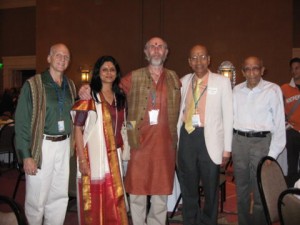
( Dr. Frawley at >> NAMA conference << with Shambhavi and Dr. Lad)
The Yoga Tradition
David Frawley, Pandit, Vedacharya
Abstract: To bring out the full healing potential of Yoga, what we need is not just Yoga therapists applying the tools of Yoga according to the guidelines of Western medical doctors. What we need in the long run are Yogic doctors who can diagnose and treat disease according to the Yogic medical system of Ayurveda. This article explores the separation of Yoga therapy and Ayurveda in the West and how they may be brought together.
>>> A Call for a Complete Yogic System of Medicine <<<
The effectiveness of a therapy depends upon the medical system according to which it is prescribed. In this regard, the question arises: What medical system is Yoga therapy depending upon for its diagnosis and treatment-and is that medical system in harmony with Yogic principles?
There is a comprehensive medical system-one of the oldest in world-that is based on Yogic principles. It has a long history of usage with Yoga and is in resurgence today. This is the Ayurvedic system of medicine of India, which remains commonly practiced in India and is now spreading worldwide.
To bring out the full healing potential of Yoga, what we need is not just Yoga therapists applying the tools of Yoga according to the guidelines of medical doctors, however helpful that can be. What we need in the long run are Yogic doctors, Yogic physicians who can diagnose and treat disease according to a medical system that is Yogic in nature. That Yogic medical system need not be invented. It is already here in the form of Ayurveda.
>> Yoga & Ayurveda, a call for a complete yogic System of Medicine
AYURVEDA: Complementary Global Medicine

> 7th Annual NAMA Conference <
NAMA’s annual conference is an opportunity to come together as a community, and for practitioners to enrich their knowledge by participating in continuing education programs and case study presentations. The weekend provides a valuable networking experience for attendees to connect or reconnect with friends and colleagues.
Ayurveda & Shivas Geheimnis
> SAVE GANGA & SHIVAS GEHEIMNIS <
by Dr. Vinod Verma
>> THE NEW WAY HEALTH ORGANIZATION .NOW. <<
(For promoting holistic living with Yoga and Ayurveda)
Dr. Vinod Verma is founder and Director of the New Way Health Organization in India and has an Ayurvedic Center in Garhwal. She has written five other books on yoga and ayurveda which have been published in various languages including German, French, Dutch and Hindi.
Dr. Verma lectures and holds seminars all over the world. She has also done many radio and TV programmers in Europe.
Shiva ist der Gott der Zeit. Das alte indische Heilwissen ist eng verbunden mit seinen Energien. Das Geheimnis von Gesundheit und einem langen Leben besteht darin, in Harmonie mit dem kosmischen Rhythmus zu leben, mit dem eigenen Lebensalter, der Tageszeit, der Jahreszeit.
Vinod Verma entschlüsselt diese Prinzipien aus alten vedischen Texten und leitet aus Shivas sagenumwobenen Geschichten konkrete Tipps und Rezepte ab, um den Körper zu entgiften, zu verjüngen und wieder in ein harmonisches Gleichgewicht zu bringen. Endlich im Handel! Buch kaufen > HIER .
Ursprung Ayurvedas innerhalb der Kulturen
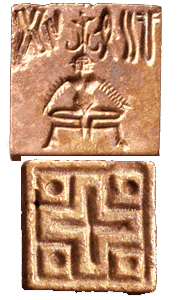
> www.harappa.com <
> Harappan Civilisation < > Die Indus Kultur (Harappa-Kultur) <
Am Fusse des Himalaya Gebirges bzw. im Flusstal des Indus, im Norden Indiens, lebten vor ca. 5000 Jahren eine wohlhabende Gesellschaft die der „Göttlichen Mutter“ diente.
Tirthas in der Architektur, Ayurveda & Yoga

TIRTHA & DIE HEILIGEN WASSER
> THE TEMPLE OF THE DANCING SHIVA <
>>* NAGESHVARA NATARAJA *<< By Raja Deekshithar
> Shivaganga, the tirtha or sacred water place, the 100 pillars <
> Die Tempelstädte Tamil Nadu, Nataraja-Tempel von Chidambaram <
Das ist einer der ältesten, am meisten verehrten und prächtigsten Tempel in Tamil Nadu. Der Tempel gilt als eine der fünf Tanzhallen Shivas, wo er seinen kosmischen Tanz vollführt. Die anderen vier Tanzhallen sind in Madurai, Tiruvalankadu, Tirunelveli und Kutralam. Nataraja ist der tanzende Shiva, Shiva Nataraja. Shiva steht in der Tanzkunst über allen Göttern, er ist Meister aller 108 Tanzformen. Gemäß der Legende versuchten einige irrgläubige Rishis Shiva durch magische Gesänge zu vernichten. Shiva erkannte die drohende Gefahr und fing an zu tanzen, wodurch die negativen Kräfte der Rishis neutralisiert wurden. Die Rishis wurden sauer und schufen den ignoranten Zwerg Aspama (auch Apasmara Purusha), der sich auf Shiva stürzte. Der böse Zwerg geriet aber bei seinem ersten Angriffsversuch unter einen Fuß des tanzenden Shivas, wodurch ihm das Rückgrat zerbrochen wurde. Die Vernichtung des Zwerges Aspama steht für die Befreiung der Welt von Ignoranz und Unwissenheit. Der böse Dämon, auf dem Shivas rechter Fuß steht, symbolisiert die Unwissenheit, die uns unser Gleichgewicht und Bewußtheit verlieren läßt.
Shivas Freudentanz (Anandatandava) symbolisiert den natürlichen und einen unaufhörlichen Prozeß von Schöpfung, Erhaltung und Zerstörung,- /wie in der Natur (Naturkreislauf)/. Der Tempel wird daher Nataraja-Tempel oder auch Sabhanayaka-Tempel genannt.
Chidambaram ist auch einer der fünf Elemente-Linga-Tempel, hier wird der Raum/Äther/Ether repräsentiert (Aakasa-Stalam).
Buchtipp: Neti im Ayurveda & Yoga

> NETI: HEALING SECRETS OF YOGA & AYURVEDA <
Neti (Sanskrit, f., नेती, netÄ�) bezeichnet im allgemeinen die Reinigung der Nase durch eine der sogenannten Shatkriyas des Hatha Yoga. Es werden zwei wichtige unterschiedliche Reinigungstechniken unterschieden, die aber oft auf einander folgend praktiziert werden.
Unter dem Begriff Jala Neti (Sanskrit, f., जल jala „WASSER“) wird die Nasenspülung verstanden. Hierbei lässt man Wasser, mit Hilfe eines Kännchens, durch ein Nasenloch ein- und dann aus dem anderen Nasenloch wieder herauslaufen.
Die Reinigung der Nase ist im Yoga von ganz besonderer Wichtigkeit, um Pranayama und Meditation zu üben, da hierfür beide Nasengänge frei sein müssen, damit ein durch beide Nasenlöcher gleichmäßig fließender Atem gewährleistet ist. Die Reinigung der Nase ist aber auch im Ayurveda von großer Bedeutung.
Sutra Neti ist die Variante, bei der ein Faden (Sutra) durch die Nase und aus dem Mund gezogen wird (in modernen Versionen wird auch anstelle des Fadens ein Katheter verwendet). Hierdurch werden die Schleimhäute in Rachenraum und Nase stimuliert, was zu einer besseren Durchblutung und zur Verbesserung der Funktion dieser Organe führen soll. Der Faden kann vorher eingeölt werden, um eine angenehme Praxis zu ermöglichen.
- Sutra Neti – Mit Gummi Katheter oder gewachster Neti Schnur
- Dughda Neti – Mit lauwarmer Kuhmilch
- Grhta Neti – Mit leicht angewärmten Butterschmalz (ghee)
- Jala Neti – Mit gesalzenem Wasser und Nasenkännchen

